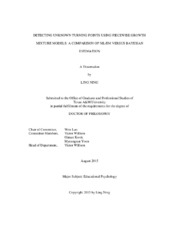| dc.description.abstract | Piecewise growth mixture modeling (PGMM) can be used to investigate growth and change of subpopulations consisting of distinct developmental phases (Muthén, 2008). The major difficulty in specifying a PGMM is how to optimally locate a turning point (or transition point, or knot). Recently, Kohli, Harring, and Hancock (2013) proposed a version of a two-stage (or two-piece) PGMM that allows free estimation of a turning point. The procedure offers more advantages over the practice of determining a turning point a priori. Yet, many questions regarding the performance of the procedure remain to be answered. The dissertation conducted comprehensive Monte Carlo simulation studies to investigate and compare the performance of the proposed procedure under two dominant estimation methods: Bayesian estimation framework via the Markov Chain Monte Carlo (MCMC) algorithm and the Maximum likelihood estimation via the expectation maximization (EM) algorithm (ML/EM).
The dissertation consisted of two studies. Study One used a two-piece PGMM as the population model to generate data and compared the performance of a PGMM with unknown turning points under both estimation methods with regard to parameter recovery, and individual classification accuracy in different experimental conditions. It was found that individual classification accuracy under both estimation methods varied depending on the separation of the latent classes and the number of time points. Overall, the Bayesian method with informative priors gave a more accurate individual classification than the same method with other prior specifications and the ML/EM method. As for the recovery of true parameter, with exception to the Bayesian method with informative priors, which was found to be able to recover the fixed effects in both classes to an acceptable degree, the same method with other prior specifications and the ML/EM method had difficulty in recovering the fixed effects, particularly, the second slope of class two. Both estimation methods were also found to have difficulty in estimating random effects.
Study Two explored and compared the accuracy of commonly used enumeration indexes with PGMMs in identifying the correct number of latent classes under both Bayesian and ML/EM estimation methods. The findings showed that, for the ML/EM method, the ICL-BIC was the most useful index in correct model identification across all the data conditions under examination. For the Bayesian method, the WAIC2, DIC3,and BIC could be used with confidence in class enumeration with PGMMs.
The findings can help applied researchers determine under what conditions a PGMM performs better fitted by one estimator than the other. The findings also provide reasonable ways for using model fit statistics in combination to decide an optimal PGMM analyzed by either the ML/EM or the Bayesian method. | en |


